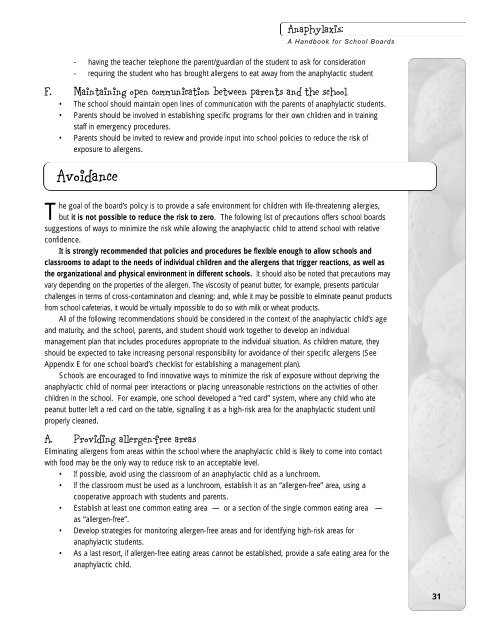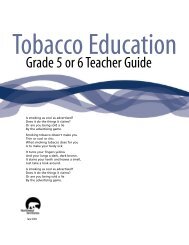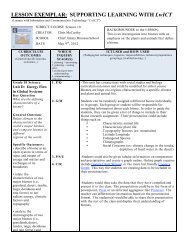Anaphylaxis: A Handbook for School Boards - Education, Culture ...
Anaphylaxis: A Handbook for School Boards - Education, Culture ...
Anaphylaxis: A Handbook for School Boards - Education, Culture ...
Create successful ePaper yourself
Turn your PDF publications into a flip-book with our unique Google optimized e-Paper software.
- having the teacher telephone the parent/guardian of the student to ask <strong>for</strong> consideration- requiring the student who has brought allergens to eat away from the anaphylactic studentF. Maintaining open communication between parents and the school• The school should maintain open lines of communication with the parents of anaphylactic students.• Parents should be involved in establishing specific programs <strong>for</strong> their own children and in trainingstaff in emergency procedures.• Parents should be invited to review and provide input into school policies to reduce the risk ofexposure to allergens.TheAvoidance<strong>Anaphylaxis</strong>:A <strong>Handbook</strong> <strong>for</strong> <strong>School</strong> <strong>Boards</strong>goal of the board’s policy is to provide a safe environment <strong>for</strong> children with life-threatening allergies,but it is not possible to reduce the risk to zero. The following list of precautions offers school boardssuggestions of ways to minimize the risk while allowing the anaphylactic child to attend school with relativeconfidence.It is strongly recommended that policies and procedures be flexible enough to allow schools andclassrooms to adapt to the needs of individual children and the allergens that trigger reactions, as well asthe organizational and physical environment in different schools. It should also be noted that precautions mayvary depending on the properties of the allergen. The viscosity of peanut butter, <strong>for</strong> example, presents particularchallenges in terms of cross-contamination and cleaning; and, while it may be possible to eliminate peanut productsfrom school cafeterias, it would be virtually impossible to do so with milk or wheat products.All of the following recommendations should be considered in the context of the anaphylactic child’s ageand maturity, and the school, parents, and student should work together to develop an individualmanagement plan that includes procedures appropriate to the individual situation. As children mature, theyshould be expected to take increasing personal responsibility <strong>for</strong> avoidance of their specific allergens (SeeAppendix E <strong>for</strong> one school board’s checklist <strong>for</strong> establishing a management plan).<strong>School</strong>s are encouraged to find innovative ways to minimize the risk of exposure without depriving theanaphylactic child of normal peer interactions or placing unreasonable restrictions on the activities of otherchildren in the school. For example, one school developed a “red card” system, where any child who atepeanut butter left a red card on the table, signalling it as a high-risk area <strong>for</strong> the anaphylactic student untilproperly cleaned.A. Providing allergen-free areasEliminating allergens from areas within the school where the anaphylactic child is likely to come into contactwith food may be the only way to reduce risk to an acceptable level.• If possible, avoid using the classroom of an anaphylactic child as a lunchroom.• If the classroom must be used as a lunchroom, establish it as an “allergen-free” area, using acooperative approach with students and parents.• Establish at least one common eating area — or a section of the single common eating area —as “allergen-free”.• Develop strategies <strong>for</strong> monitoring allergen-free areas and <strong>for</strong> identifying high-risk areas <strong>for</strong>anaphylactic students.• As a last resort, if allergen-free eating areas cannot be established, provide a safe eating area <strong>for</strong> theanaphylactic child.31
















